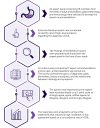Expert Recommendations on the Diagnosis of Eosinophilic Esophagitis in the United Arab Emirates
- PMID: 38618346
- PMCID: PMC11009821
- DOI: 10.7759/cureus.56062
Expert Recommendations on the Diagnosis of Eosinophilic Esophagitis in the United Arab Emirates
Abstract
Eosinophilic esophagitis (EoE) is a chronic, progressive, type 2 inflammatory esophageal disease presenting as dysphagia to solid food and non-obstructive food impaction. Knowledge gaps exist in its diagnosis and management. These expert recommendations focused on the diagnosis of EoE in the United Arab Emirates. An electronic search of PubMed and Embase databases was used to gather evidence from systematic reviews, randomized controlled trials, consensus papers, and expert opinions from the last five years on the diagnosis of EoE. The evidence was graded using the Oxford system. Literature search findings were shared with the expert panel. A 5-point scale (strongly agree, agree, neither agree nor disagree, disagree, and strongly disagree) was used, and a concordance rate of >75% among experts indicated agreement. Using a modified Delphi technique, 18 qualified experts provided 17 recommendations. Eleven statements achieved high agreement, four got moderate agreement, and two got low agreement. Challenges exist in diagnosing EoE, particularly in children. Esophageal biopsies were crucial in diagnosis, irrespective of visible mucosal changes. Further research on diagnostic tools like endoscopic mucosal impedance and biomarkers is needed. Diagnosis relies on esophageal biopsies and symptom-histology correlation; however, tools like EoE assessment questionnaires and endoscopic mucosal impedance could enhance the accuracy and efficiency of EoE diagnosis. The diagnosis of EoE is challenging since the symptoms seldom correlate with the histological findings. Currently, diagnosis is based on patient symptoms and endoscopic and histological findings. Further research into mucosal impedance tests and the role of biomarkers is needed to facilitate diagnosis.
Keywords: eosinophilic esophagitis; gastroesophageal disease; recommendations and guidelines; type 2 inflammation; united arab emirates.
Copyright © 2024, Awadhi et al.
Conflict of interest statement
The authors have declared financial relationships, which are detailed in the next section.
Figures
References
-
- Applications of artificial intelligence to eosinophilic esophagitis. Smith ER, Shah J. Gastroenterol Insights. 2022;13:218–227.
-
- Eosinophilic esophagitis: current status and future directions. Kumar S, Choi SS, Gupta SK. Pediatr Res. 2020;88:345–347. - PubMed
-
- Systematic review with meta-analysis: the incidence and prevalence of eosinophilic oesophagitis in children and adults in population-based studies. Arias Á, Pérez-Martínez I, Tenías JM, Lucendo AJ. Aliment Pharmacol Ther. 2016;43:3–15. - PubMed
Publication types
LinkOut - more resources
Full Text Sources

